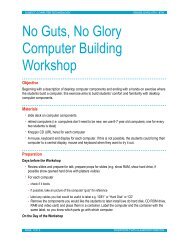Workshop Report - Pervasive Technology Institute - Indiana University
Workshop Report - Pervasive Technology Institute - Indiana University
Workshop Report - Pervasive Technology Institute - Indiana University
You also want an ePaper? Increase the reach of your titles
YUMPU automatically turns print PDFs into web optimized ePapers that Google loves.
• The reward system for faculty developing CI does not encourage effort spent on supporting<br />
users of the CI. Changing that rewards system would be difficult, and finding other avenues to<br />
support that CI should be explored.<br />
3.2. Importance of campuses in CI education and workforce<br />
development<br />
Discussions during the workshop emphasized the critical role of people in CI and the importance<br />
of their CI-related education and training. One aspect is that a well-trained workforce is critical<br />
to make CI a sustained infrastructure, with the stability, robustness and predictability the term<br />
infrastructure implies and scientists increasingly expect. The observation was made that hardware<br />
resources are increasingly cheap, but the lack of a qualified workforce for CI continues to be a<br />
challenge. Students are not generally exposed to the task of developing reliable software and<br />
systems. Their education focuses on research and prototyping; this has an impact “upstream” when<br />
these students later enter the workforce.<br />
A second aspect of CI education is the level and type of familiarity that scientists have with regards<br />
to CI. For example, new students, who will comprise tomorrow’s scientists, having grown up with a<br />
mature Internet and Web-based services, have both greater expectations of computational services<br />
in terms of usage modalities (e.g., command-line versus web), robustness, ease-of-use, etc. and, in<br />
general, less familiarity with complicated computer science concepts, command-line interfaces, and<br />
low-level development.<br />
Campuses play a critical role in training and education, both in terms of developing that workforce<br />
for CI, and in training both CS and domain scientists in what CI can do for them and how to take<br />
advantage of it. A successful strategy for enabling campus bridging needs to be providing campuses<br />
with both the motivation and expertise to provide appropriate education with regards to CI; for<br />
example, the <strong>University</strong> of Virginia has a CS 101 course for graduate students across disciplines.<br />
3.3. Relationship of NSF CI, administrative computing and<br />
commercial CI<br />
Campus computing infrastructure can generally be categorized as administrative computing,<br />
supporting business functions such as email, payroll, and enrollment; and research computing,<br />
supporting scientific research. In general, research computing infrastructure is more readily usable<br />
as part of a coordinated CI than is administrative computing infrastructure (a notable exception is<br />
identity federation). Campus leadership generally puts more emphasis on and resources behind<br />
administrative computing than research computing. While this is certainly reasonable given the<br />
strong requirements for supporting the institution on administrative computing, the workshop<br />
participants agreed that the gap could be narrowed. Outreach to CIOs, VPRs, and other campus<br />
leadership on the benefits to science of research computing could help generate more balanced<br />
levels of support for research computing on campuses. CI, in turn, could leverage the increased<br />
13






